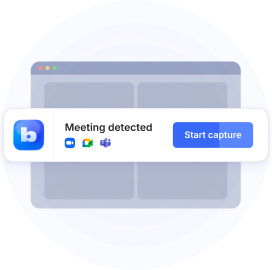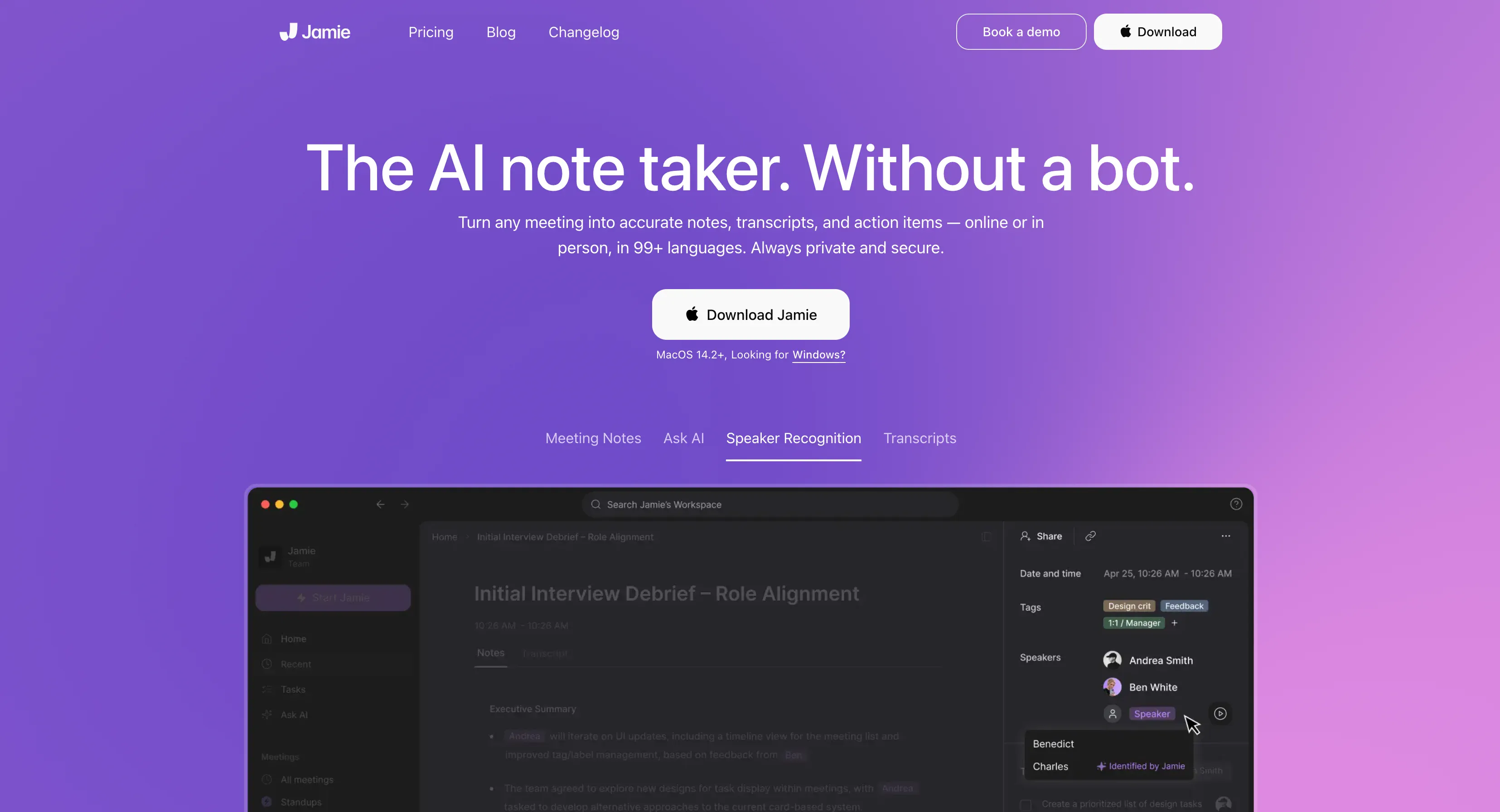
AI-powered meeting assistants remove the need for manual transcription — or the inevitable post-call sorting of chaotic meeting notes. These tools help you focus on the actual conversation instead.
Jamie AI stands out for its promise to handle transcripts, summarize key points, and tag speakers across more than 99 languages.
Still, competition in this space is intense. For many users, Jamie isn’t the most practical or affordable option. Here’s where it falls short, and which Jamie alternatives users are turning to instead.
TL;DR
- Jamie AI Alternatives are increasingly popular because users are unhappy with the platform's manual speaker tagging, limited integrations, and high pricing.
- Bluedot is a solid Jamie alternative with automatic speaker labeling, Salesforce and HubSpot integrations, browser access, and unlimited recording duration on most plans. It also includes detailed speaker analytics, multilingual transcription, and real-time summaries.
- Otter.ai is great for in-person meetings and offers accurate transcriptions and mobile access, but you still have to tag speakers manually at least once.
- Fireflies.ai stands out for its sentiment analysis and multilingual transcription, though it caps meetings at 3 hours, and some analytics features require more expensive plans.
- Fathom AI offers one of the best free plans with unlimited recordings and CRM integrations, but its limited language support and desktop requirement make it less flexible.
- Read AI delivers deep meeting analytics and performance coaching, but raises privacy concerns and demands extensive access to user data.
- For users comparing pricing, Bluedot’s Pro plan costs about half of Jamie’s equivalent tier while offering more flexibility and automation.
4 Reasons To Look for a Jamie AI Alternative
Jamie AI has a lot of stuff going for it, including offline support, a bot-free experience, and multilingual transcriptions.
Even so, the platform isn’t without flaws. And while no tool is perfect, Jamie AI’s shortcomings stand out in light of its cost. Compared to other AI meeting recorders, it simply doesn’t deliver enough value for the price.
Here are four common drawbacks users point out:
- No automatic speaker identification – You have to manually tag voices before Jamie learns who’s speaking.
- Limited integrations – It connects to a few apps but lacks support for major CRMs such as Salesforce.
- Desktop-only access – You need to install an app for Windows or Mac, with no web-based interface for quick access.
- High pricing for what’s offered – The cost is steep compared to tools that provide browser audio capture with richer integrations and full automation.
1. No Automatic Speaker Identification
Jamie AI can detect multiple voices in a recording, but doesn’t assign names automatically. You must listen to short clips from the meeting, identify each voice, and label them manually. After that, Jamie can recognize speakers in the meeting and label them automatically in subsequent recordings.
For a busy team or someone who's on daily sales calls, this is probably a deal-breaker. A meeting assistant should save you time, not create another task you have to do manually after every call with a new person. Plus, even when you identify voices yourself, Jamie can still mislabel them:
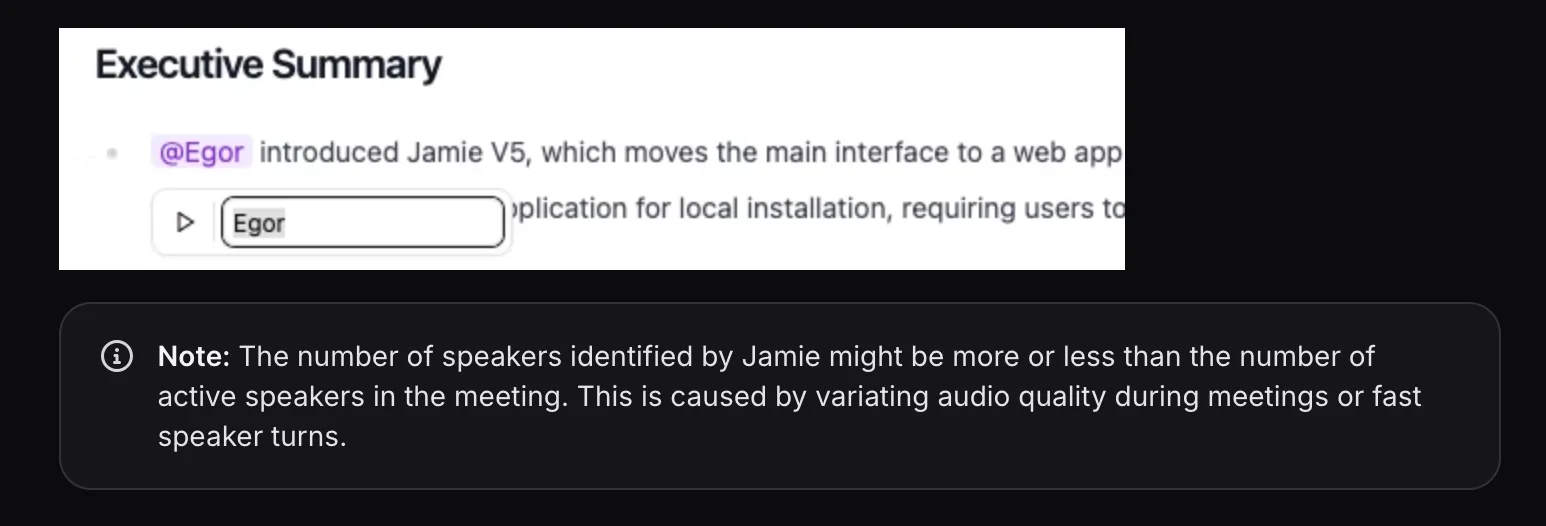
If someone's audio quality isn't pitch-perfect, Jamie AI may label the wrong speaker — especially in fast-paced group discussions. Most modern AI note takers, like Bluedot, also use participant information from calendar apps and video conferencing platforms to label speakers correctly.
2. Limited Integrations
Integrations are the backbone of any tool that wants to become a staple of serious productivity stacks. Jamie AI works fine as a standalone app, but it supports far fewer connections than competing platforms. Notably, there’s no Salesforce integration, which is a real minus for customer success and sales teams that need automated CRM updates.
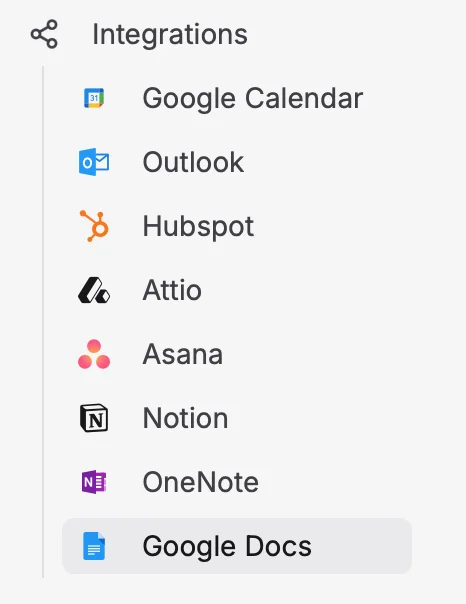
Without tight integrations, users waste time copying and pasting meeting notes and other information between systems.
That’s inefficient when other platforms let you link transcripts with tasks, tickets, or client profiles automatically. In a market where automation is the main selling point, most Jamie AI alternatives don't create this sort of bottleneck.
3. Desktop-Only Access
Jamie AI requires installing a desktop app on Windows or macOS. There’s no browser-based option, which means users can’t directly record or transcribe meetings in Chrome or another browser.

For professionals who constantly switch devices, having to install desktop apps feels dated. Browser-based AI tools are easier to deploy across teams, don’t require IT installation, and let users capture meetings on any device. The fact that Jamie relies on downloaded software limits accessibility and convenience.
4. High Pricing for Limited Flexibility
Jamie's paid plans are at the higher end of the market, even though they lack several features that competitors include by default. For smaller teams and startups, it’s hard to justify paying premium rates without automatic speaker labeling, deep integrations, or browser access.
Here's an overview of Jamie AI's pricing plans:
As you can see, Jamie AI has a few key limitations, including:
- Limited number of messages with the platform's AI assistant, on almost all premium plans,
- Limited call duration on every plan.
Most other AI meeting assistants don't impose similar limits — especially with hefty subscription prices.
What's the Best Jamie AI Alternative?
Most users who grow frustrated with Jamie AI switch to one of the following AI meeting assistants:
- Bluedot
- Otter
- Fireflies AI
- Fathom AI
- Read AI
Let's check out each platform in more detail and compare it with Jamie AI.
#1. Bluedot — Great For Real-Time Transcription & Meeting Recordings
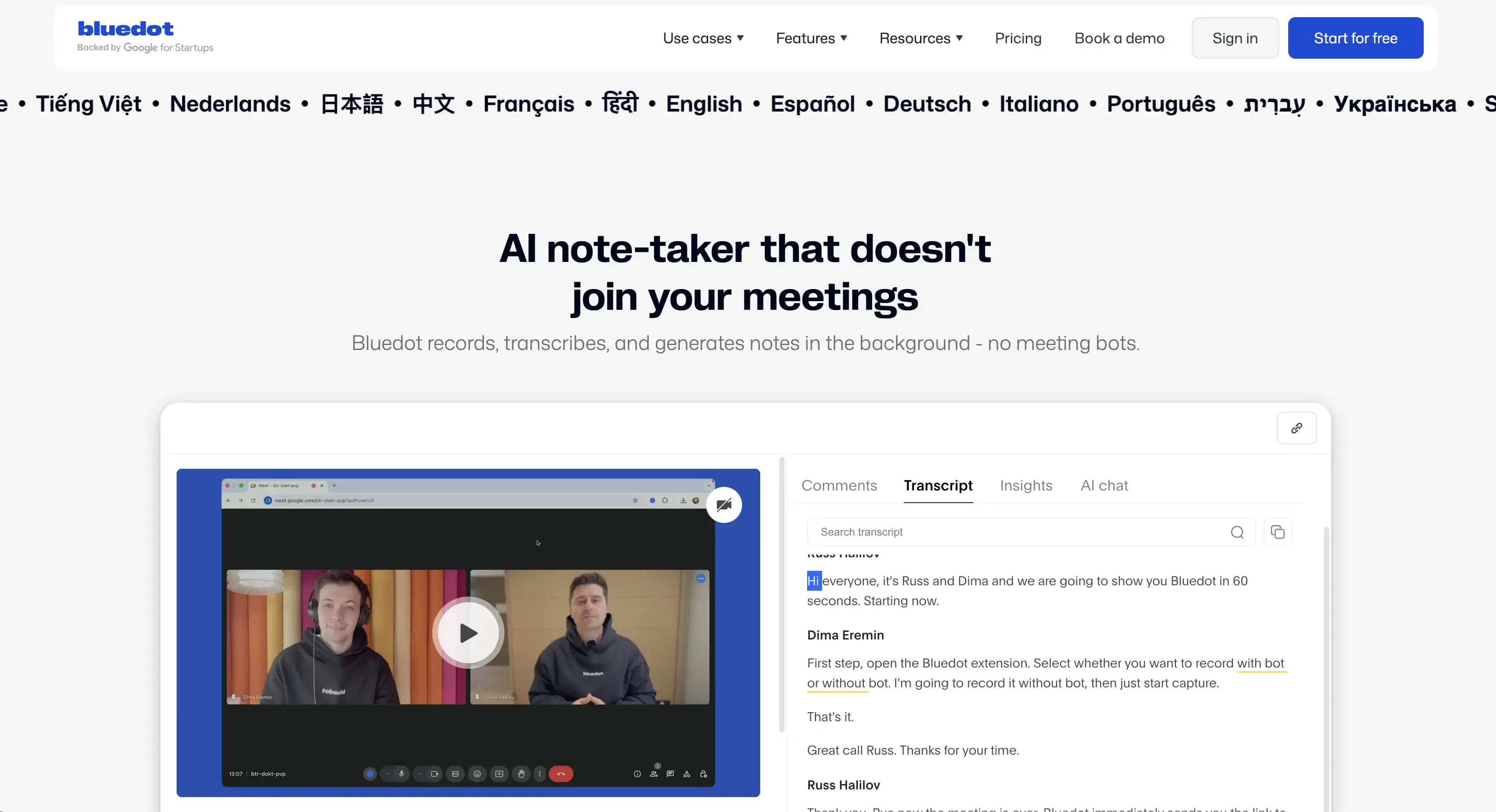
Bluedot is an AI meeting assistant that can record your calls in video conferencing platforms like Google Meet, Microsoft Teams, and Zoom. Then, it automatically transcribes, summarizes, and converts video or audio into notes you can search and edit.
Why is it a better choice than Jamie AI? Let's dive in and find out.
Bluedot vs. Jamie AI
For starters, Bluedot has automatic speaker labeling that just works. Sure, you can edit the labels if you want to — but it's not required, even the first time you record someone on a call. It's leaps and bounds ahead of Jamie's speaker identification, which requires you to label everyone yourself at least once.
On top of that, Bluedot automatically provides valuable insights about each speaker on your calls.

This visual report shows you useful information like:
- Longest monologues of each speaker,
- Speakers' average talking speeds, and
- Talk ratios of all meeting participants.
Bluedot also supports more integrations with other productivity tools than Jamie AI — including a handy Salesforce integration.
It sends relevant meeting notes to your Salesforce Tasks tab for each contact after a call. Also, you can do the same with deals on HubSpot. This makes Bluedot a stronger option for teams that rely on CRM workflows.
Furthermore, Bluedot works via a browser extension rather than a separate desktop client. This allows more flexibility for teams working across different devices.
Still, Jamie AI's biggest downside is low cost-effectiveness — while Bluedot gets you more value on any budget.
Bluedot Pricing Explained
Here's what you get for each Bluedot subscription — and how much they cost:
Bluedot delivers superior value at lower prices. The Pro tier begins at US $20/month, while Jamie AI’s comparable tier costs around US $50/month, yet still limits meeting duration to 3 hours and has fewer integrations.
Unlike Jamie AI, Bluedot offers unlimited meeting duration with two of its paid plans. Also, none of the plans limit the number of messages in Bluedot's AI chat.
Bluedot Pros and Cons
Here's a summary of the relative advantages and drawbacks of Bluedot:
#2. Otter.ai — Great For In-Person Meetings
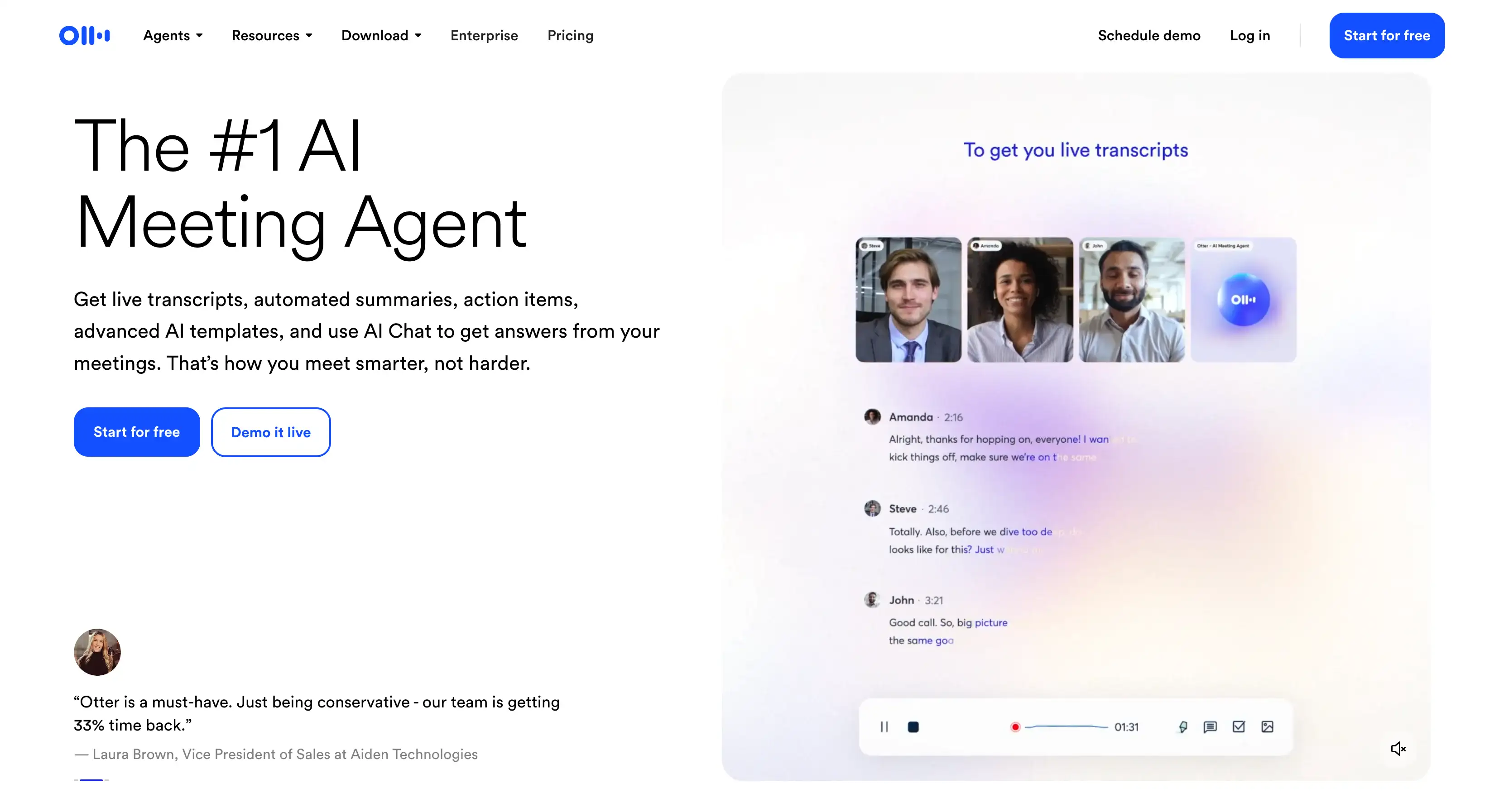
Otter.ai is an AI-powered transcription and meeting platform that captures, summarizes, and organizes spoken content from live calls, uploaded recordings, or in-person meetings.
Let's see why it's one of our top picks for an AI-powered Jamie alternative.
Otter AI vs. Jamie AI
Jamie AI’s manual speaker tagging is one of its biggest time sinks — and Otter.ai partially improves on that drawback.
On the one hand, Otter.ai still requires you to tag new speakers when they're detected for the first time. However, it identifies speakers automatically based on stored profiles and meeting data more accurately.
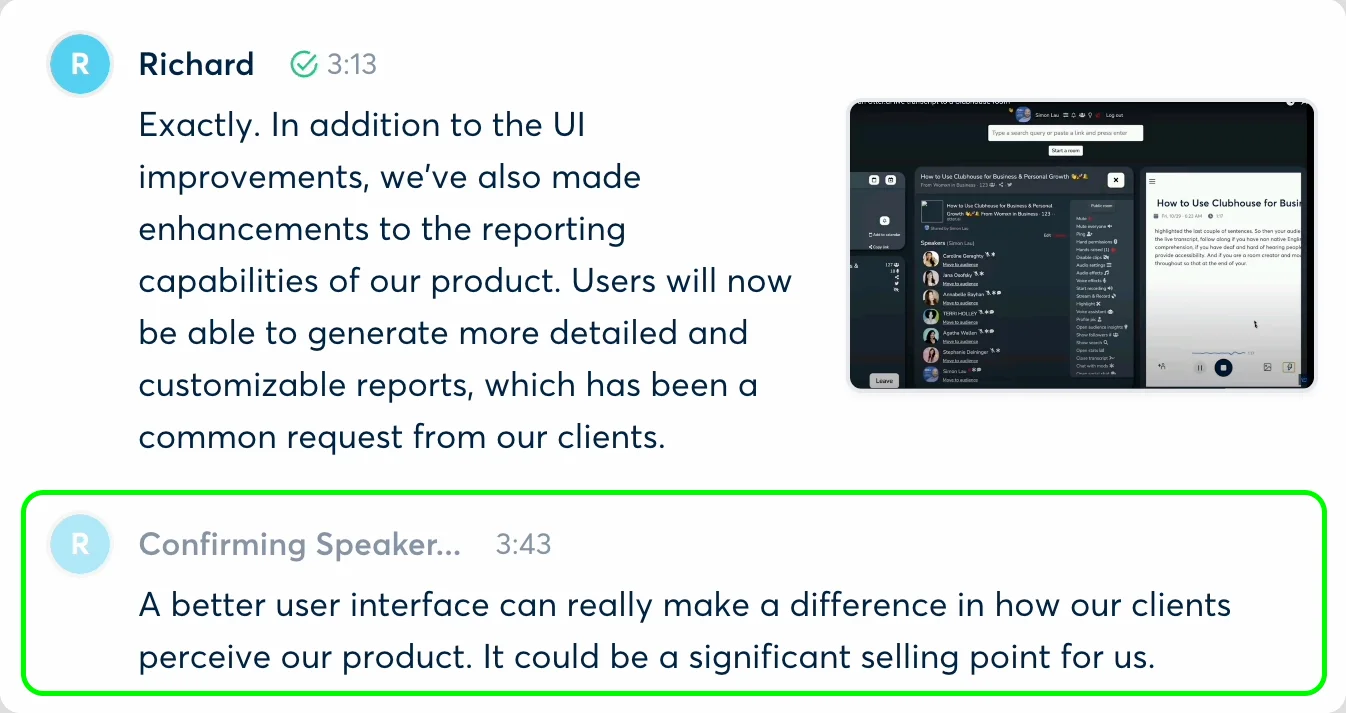
Otter’s model can easily recognize distinct voices and group speech by speaker. As a result, you get cleaner, more searchable transcripts. OtterPilot (the platform's note-taking bot) can also tag users in real time when it joins a Zoom meeting.
While Jamie AI’s limited integrations make it less ideal for sales and other customer-facing tech stacks, Otter.ai integrates with popular CRMs, like:
- Salesforce — allowing you to sync meeting conversations, insights, participants, and links directly into Salesforce tasks.
- HubSpot — letting you easily import meeting notes and insights into deals and contacts.
- Direct integration with Zoom, Microsoft Teams, and Google Meet, with automatic recording through OtterPilot.
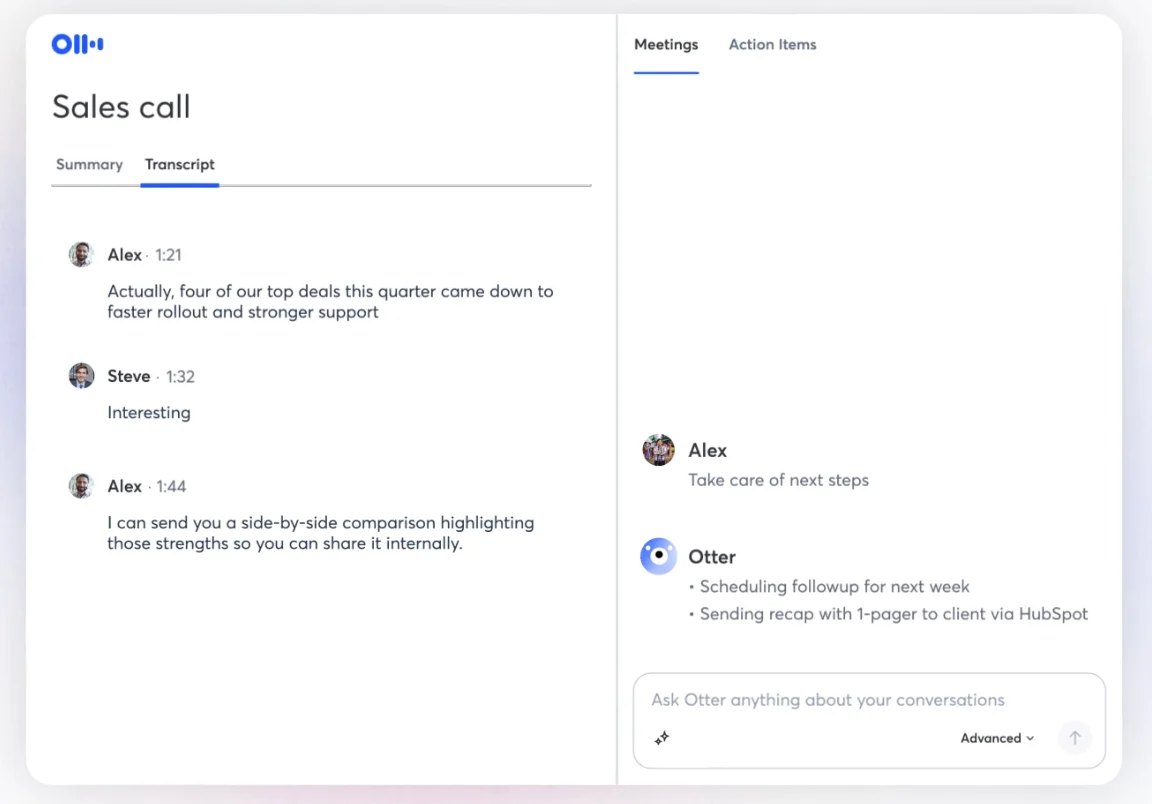
Unlike Jamie AI’s desktop-only setup, Otter.ai runs natively on browsers and mobile devices. It’s accessible via web, iOS, and Android apps. This cross-device accessibility makes it more flexible and a better choice for users who routinely attend meetings away from their desks.
And while it doesn't offer unlimited meeting length like Bluedot, Otter's 4-hour cap is slightly higher than Jamie's 3-hour limit.
Otter AI Pricing Explained
Take a quick look at Otter.ai's subscriptions in the table below:
Remember, Jamie AI’s Pro plan is roughly $50 USD per month with 3-hour meeting limits. On the other hand, Otter.ai’s Business plan sets you back just $20 USD/month with annual billing.
While Otter's subscription has more limitations than Bluedot's comparable plan, it still offers 4-hour sessions, 6,000 minutes per month, and unlimited storage for transcripts. Compared to Jamie, you definitely get more value for your money.
Otter Pros and Cons
Not sure whether to go for Otter.ai or look for an alternative? Here's the bottom line:
#3. Fireflies.ai — Great for Sentiment Analysis
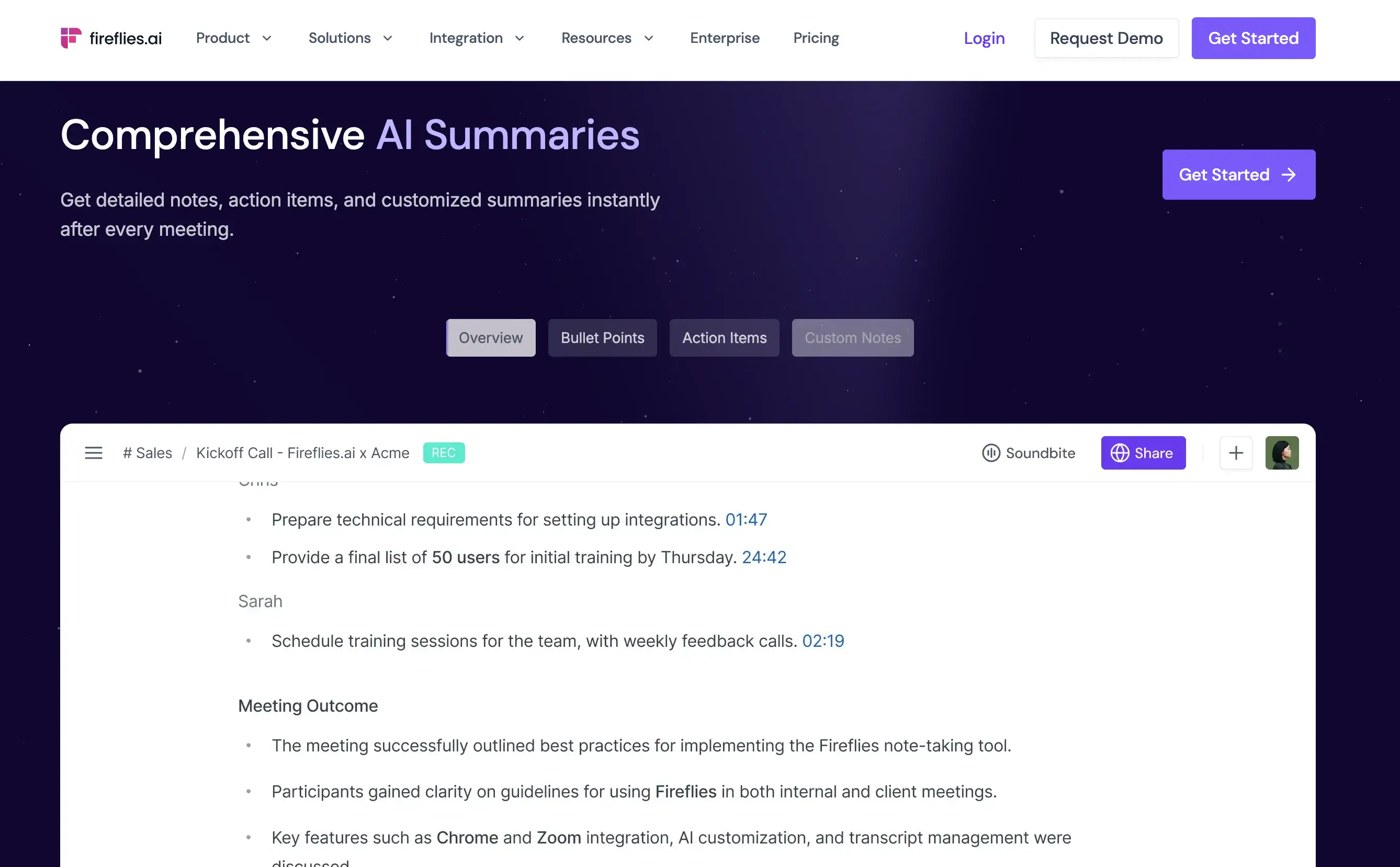
Fireflies.ai is a meeting assistant with advanced AI features, including capturing, transcribing, and summarising meetings across major conferencing platforms.
Why is it an improvement on Jamie AI? Keep reading to find out!
Fireflies AI vs Jamie AI
Jamie AI requires manual speaker tagging before it can automatically label speakers. In contrast, Fireflies.ai’s Chrome extension allows automatic speaker labelling and full bot-free recording for Google Meet calls.
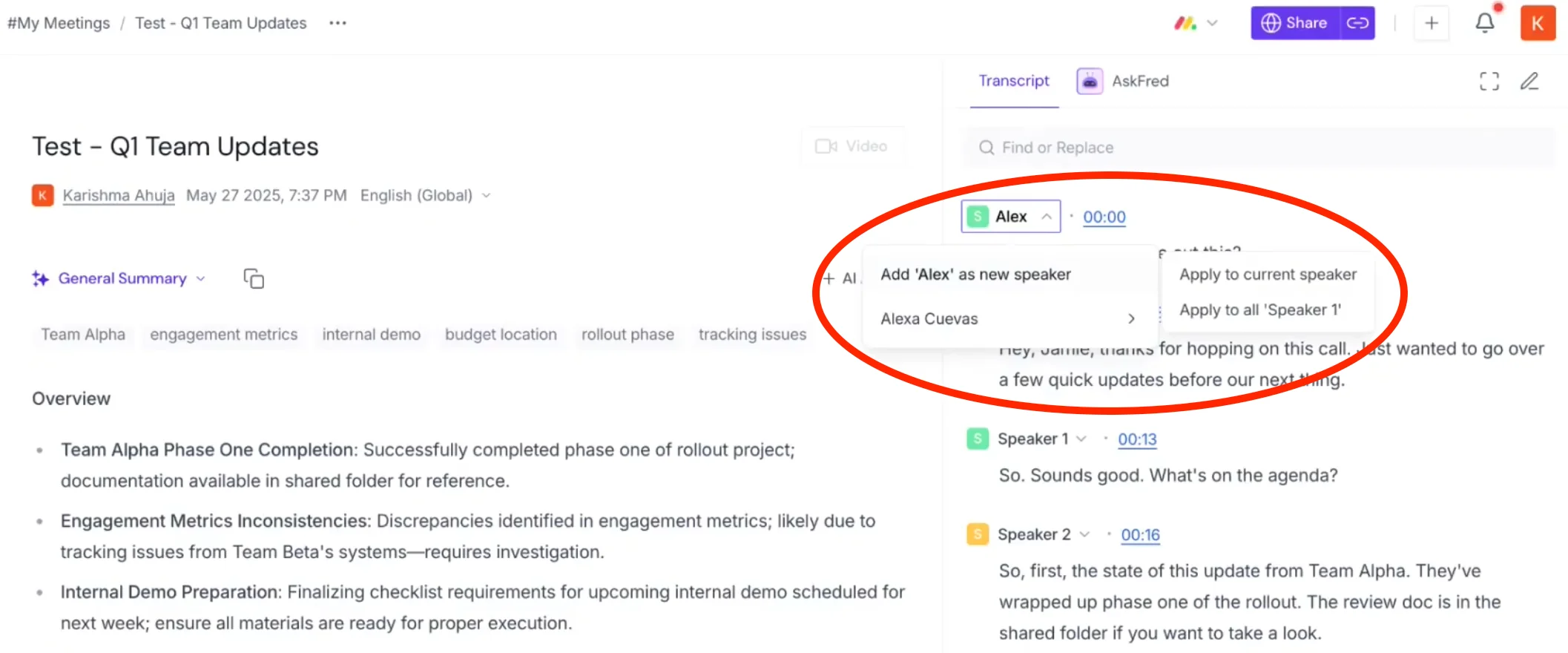
However, you may still need to tag speakers manually in Fireflies. This is necessary if you've uploaded an audio file that doesn't contain speaker metadata or used the Fireflies mobile app. Right now, the platform's mobile transcriptions often don't detect speakers automatically — unlike some Fireflies alternatives.
In terms of integrations, Fireflies is also a better choice than Jamie. The former provides wider integration support with CRM tools, including Salesforce and HubSpot. However, the platform's most unique feature is definitely sentiment analysis.
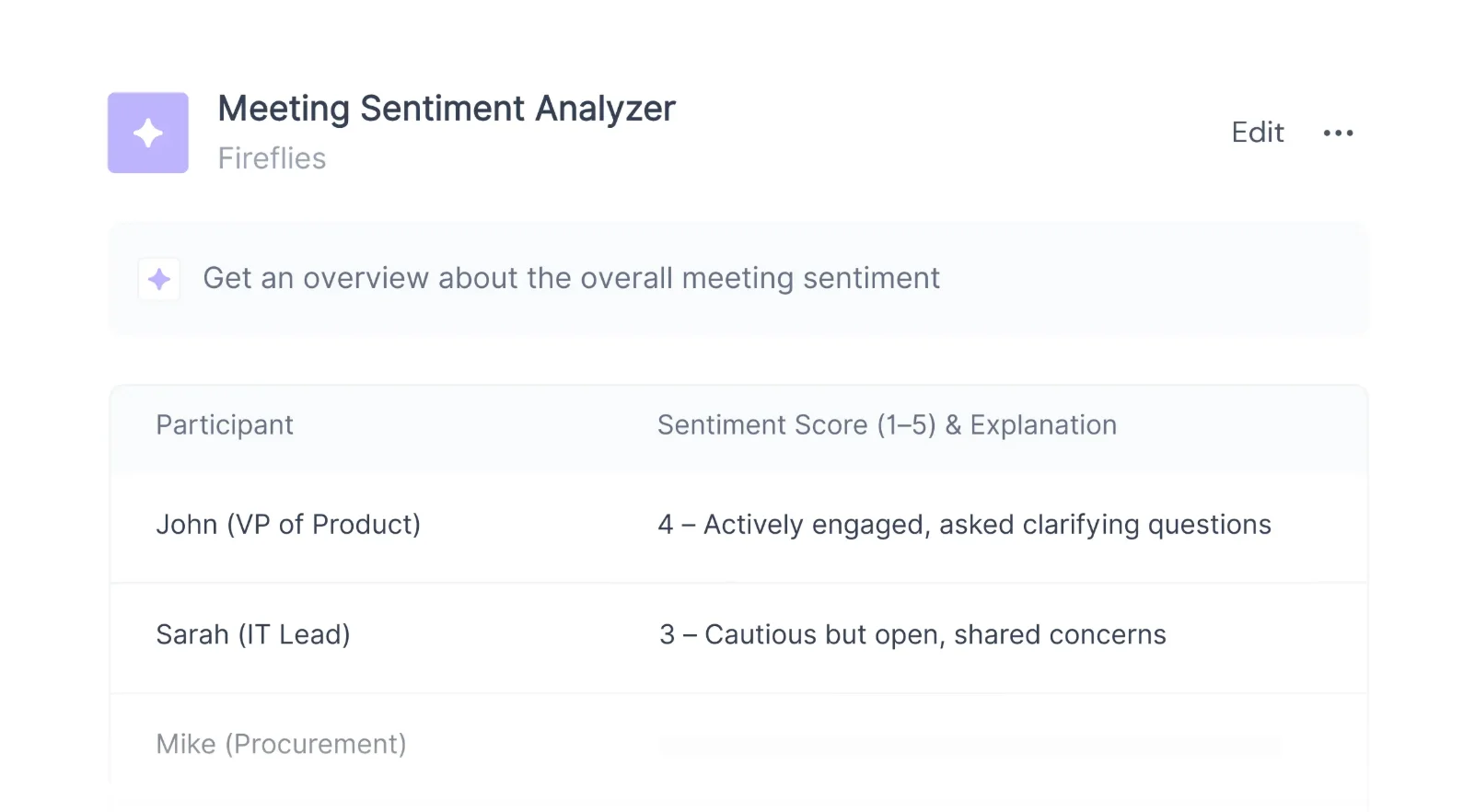
Fireflies’ sentiment-analysis capability lets you “detect sentiment” among speakers in your meetings.
The platform automatically categorizes essential keywords or phrases into positive, negative, and neutral sentiments. This immediately shows you how well a call went.
You can also apply a Sentiment Filter to your transcripts and view only parts of the conversation with a specific disposition. For example, you can jump directly to negative statements that you need to address.
Unfortunately, Fireflies AI doesn't offer unlimited meeting recordings — limiting them to 3 hours even on paid tiers. However, its paid tiers are priced more reasonably than Jamie AI's subscriptions.
Fireflies Pricing Explained
Wondering if Fireflies is the most cost-effective AI meeting assistant for your needs? Check out its different subscription tiers below:
Considering its advanced features for data and sentiment analysis, Fireflies' subscriptions provide more value — and start at significantly lower monthly rates than Jamies AI.
Fireflies AI Pros and Cons
Not sure if Fireflies.ai is worth its price for your team? Here’s what you need to know:
Read More: Fireflies AI vs. Otter AI vs. Bluedot
#4. Fathom — Excellent Free Meeting Tool
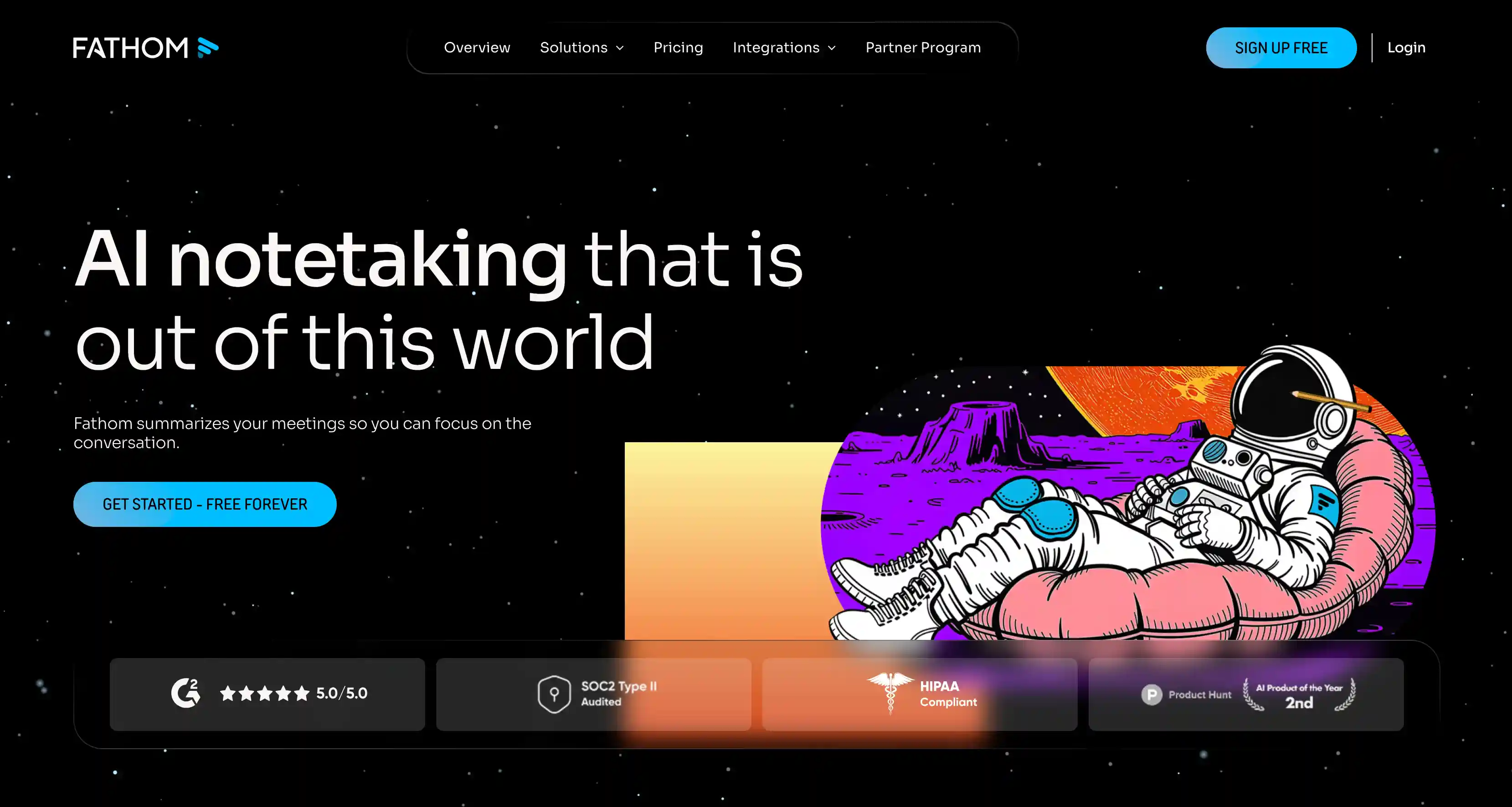
Fathom AI is an AI-powered meeting assistant that records, transcribes, and organizes calls on Zoom, Google Meet, and MS Teams. It promises multilingual support in 25 languages, unlimited recordings & transcription, and unlimited recording length — all in its free tier.
The question is — does Fathom AI work better than Jamie, or at least give you a better deal? Let's find out.
Fathom AI vs. Jamie AI
Jamie AI requires you to manually label speakers after you capture your first meeting with them. In Fathom, you won't have to — the platform supports automatic speaker labelling. However, you can edit the labels manually because Fathom's model tends to struggle with accents and background noise.
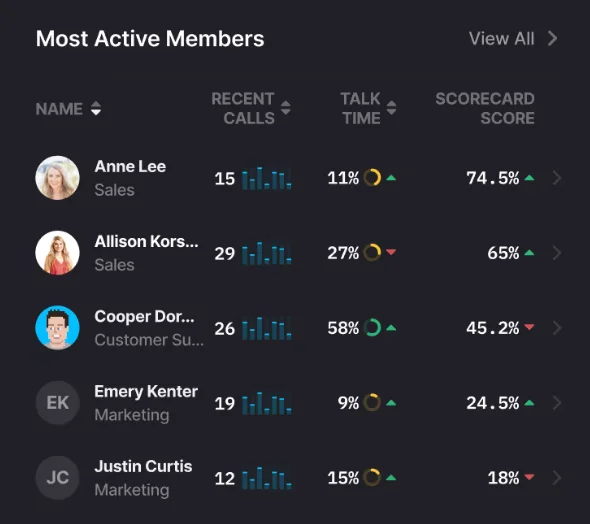
Once speakers are tagged, the platform will recognize them in subsequent conversations. You can even see their talk time in recent meetings, and an AI scorecard that evaluates their contributions.
On the integration front, Fathom AI does a lot more for you than Jamie — especially in terms of CRM data syncing. You can connect your Fathom AI account with:
- Salesforce — for importing call summaries and meeting documentation to contacts, accounts, and open opportunities, and
- HubSpot — for importing the same information to companies, contacts, and deals.
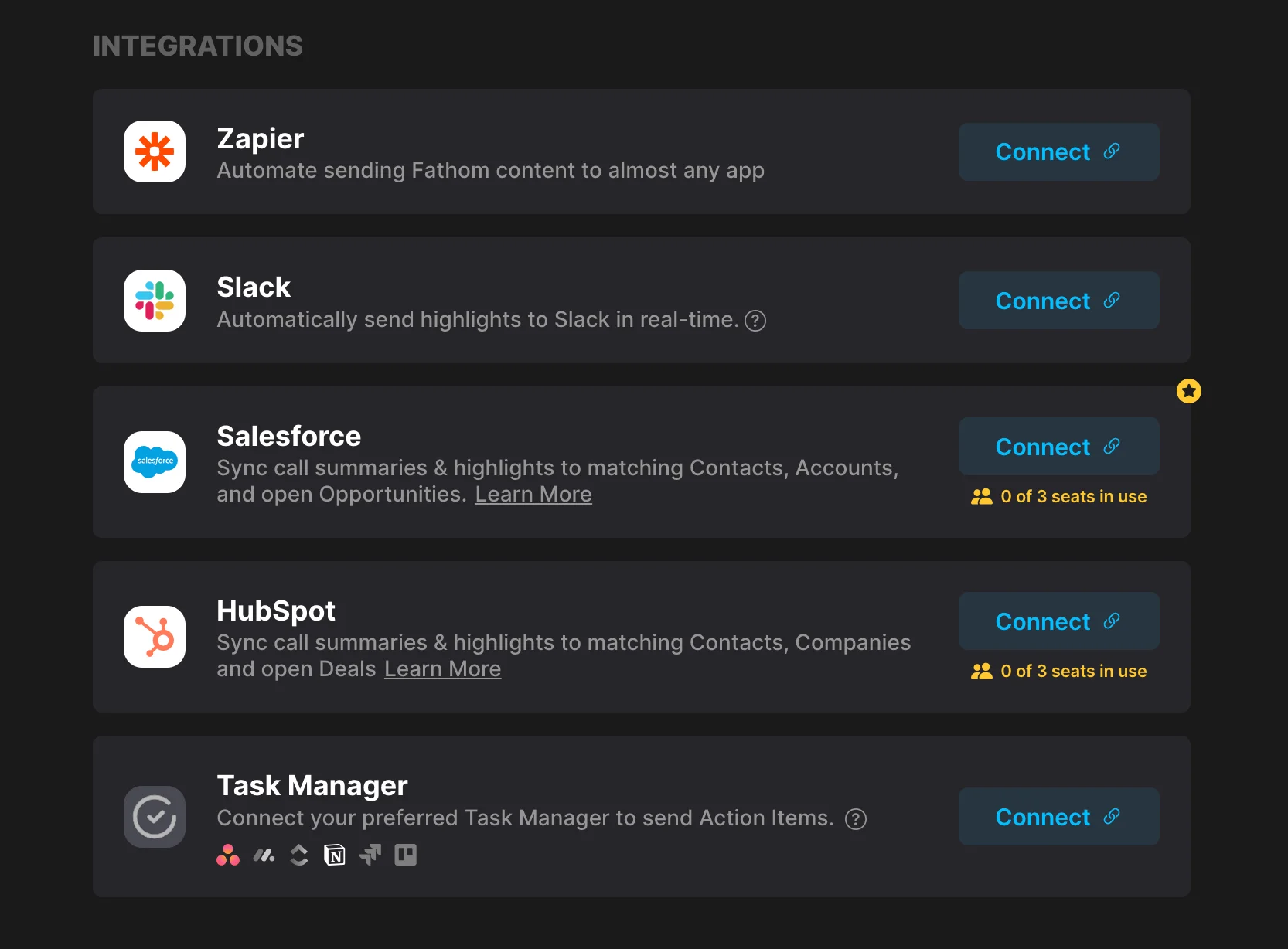
Moreover, Fathom supports other integrations via Zapier, enabling data to flow into task systems, dashboards, or automated follow-ups. This makes Fathom a great choice for teams looking to integrate an AI assistant into their existing stack.
Unfortunately, while Fathom AI's interface is primarily browser-based, it also requires you to install a desktop app — and there's no support for mobile.
The language support is decent, but its 25 languages are a far cry from apps like Bluedot, which support 100 or more.
So, how does Fathom stand out among other Jamie alternatives? Besides a flashy website, it has one of the most robust free plans.
Fathom AI Pricing Explained
Let's examine what you get with each Fathom AI subscription:
Few Jamie AI alternatives provide as much value in their free tier. And while Fathom doesn't include unlimited AI summaries or unlimited assistant messages, you do get unlimited transcripts, basic summaries, video and audio recordings, and recording storage — without paying a penny.
The advanced features for team collaboration and better meeting summaries are still locked behind the pricier subscriptions, but you get plenty of mileage out of the free plan.
Fathom AI Pros and Cons
Here are the main positives and negatives of using Fathom for online meetings:
Note: Want something similar to Fathom, but better-suited for your needs? Check out our guide to Fathom alternatives.
#5. Read AI — Great Jamie Alternative for Sales Teams
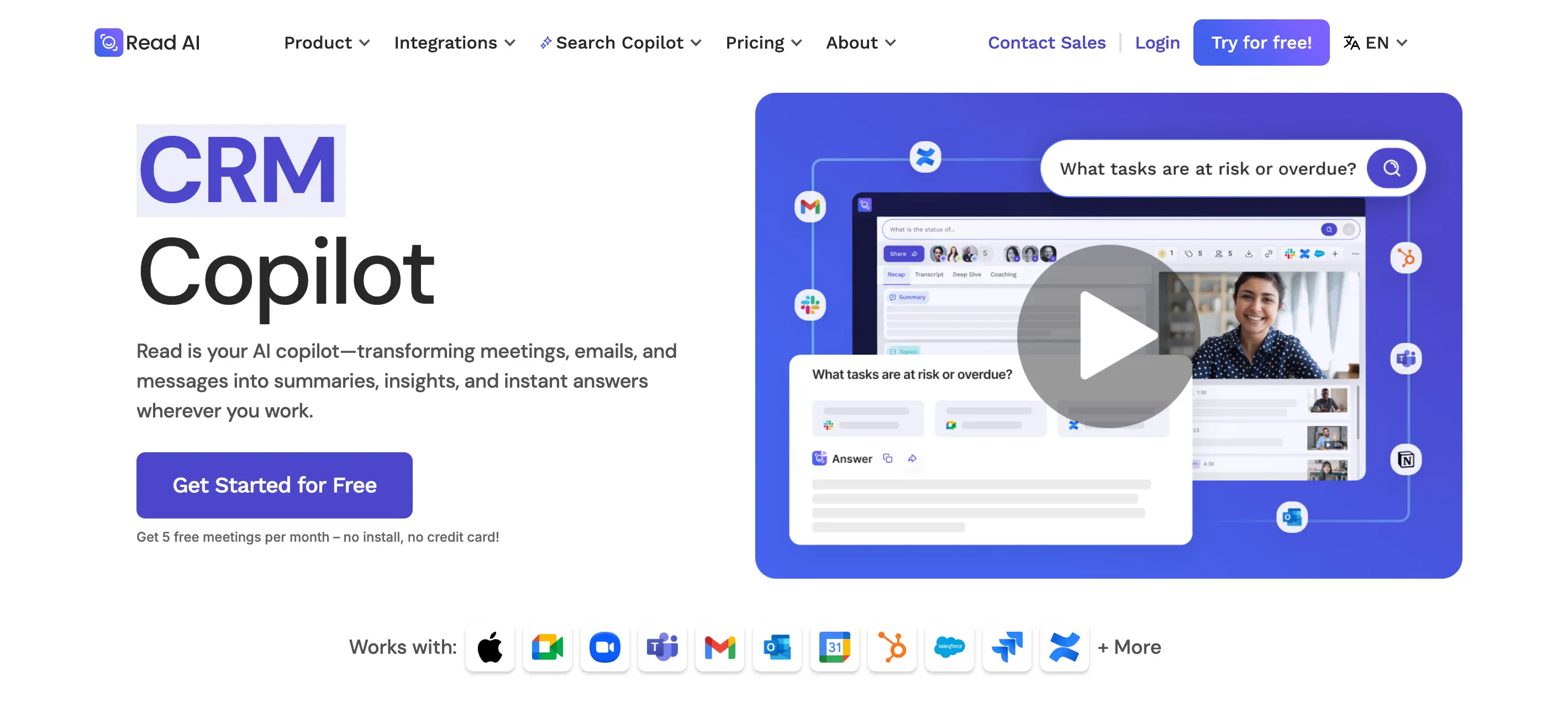
Read AI brands itself as your AI copilot — supposedly transforming meetings, emails, and messages into summaries and insights across meeting platforms and other productivity tools.
The tool is definitely a decent Jamie alternative, especially for sales coaching and meeting analytics. It goes way beyond automated meeting notes — but maybe a bit too far.
Let’s get the full picture.
Read AI vs. Jamie
In terms of Jamie's main drawbacks, Read AI is a definite improvement. The platform automatically labels speakers in your transcript and meeting notes. It also highlights points of positive and negative audience reactions in virtual meetings for each speaker.
It also makes task management easier with automated reports and a dedicated Calendar view, where you can also access meeting content from previous meetings.
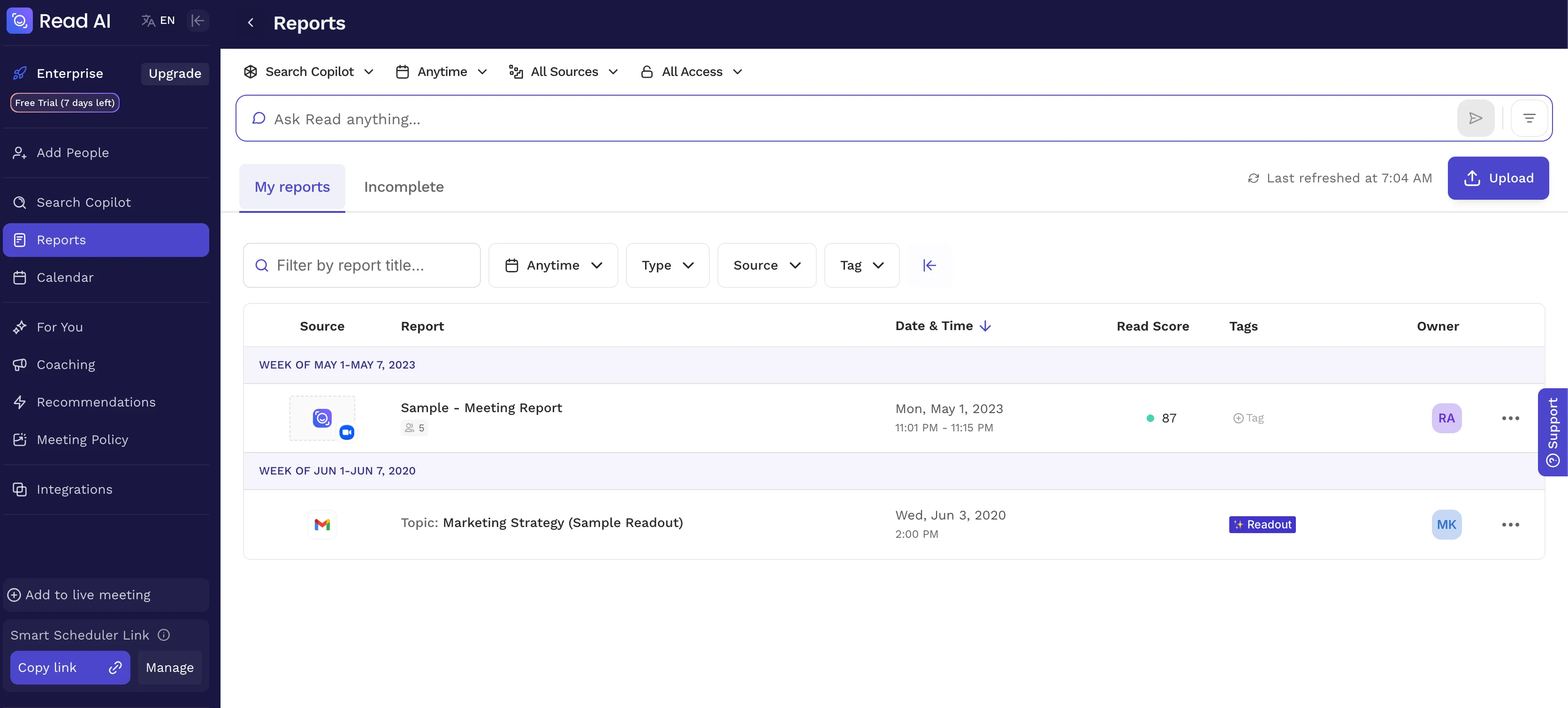
However, its practical usefulness is debatable. The Calendar view just pulls from your Google or Outlook Calendars, and most users don't want to manage their time through yet another calendar app.
Read AI's real advantage is in meeting analytics. It analyzes each meeting and automatically provides recommendations for improving your team's approach in the future.
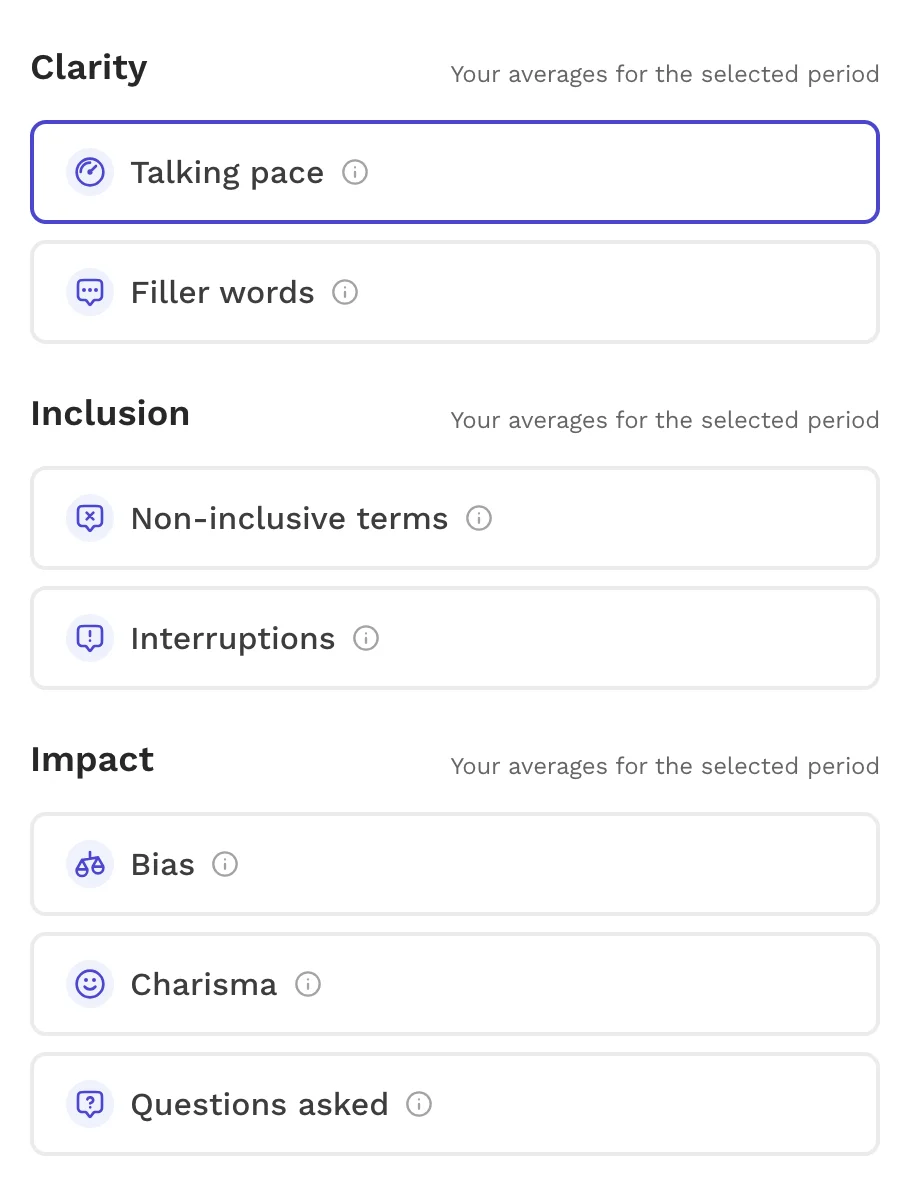
This makes the platform particularly useful for sales managers and team members with frequent sales calls.
However, Read AI may be a bit overkill if you just want to view video recordings of past meetings and get real-time transcriptions. Its interface is more reminiscent of a full-fledged CRM, and users report it's a bit too invasive.
Once you make an account, Read AI asks for access to all of your email and productivity apps — with way more permissions than you'd give any other AI meeting tool.
If you use it for transcripts in Microsoft Teams, it even automatically creates accounts for other team members in your workspace.
Privacy concerns aside, the platform's multi-language support is also a bit lacking, with only around 20 languages.
Read AI Pricing Explained
Here's all you need to know about Read AI's various pricing plans:
The Free plan mainly serves as an introduction to the platform, giving you a feel for how Read AI works before committing to a paid subscription. If you’re interested in exploring its full potential, consider trying the 7-day Enterprise free trial — it includes access to advanced analytics tools and deeper meeting content insights.
Note: If you're looking for a less intrusive alternative to Read AI, check out our guide on the topic.
Read AI Pros and Cons
Do the advanced analytics features of Read AI outweigh its privacy drawbacks? Consider all the pros and cons before making a choice:
How Did We Choose The Top AI Meeting Assistant?
To find the top Jamie AI alternatives, we tested and analyzed many of the most popular AI meeting assistants currently available.
The goal wasn’t just to rank them by name recognition, but to determine which ones genuinely save time, improve collaboration, and integrate naturally into daily workflows.
We focused on four main factors:
- Transcription & speaker labeling accuracy,
- Available integrations
- Overall usability, and
- Value for money.
We wanted to see how each tool on this list addressed Jamie’s known drawbacks — manual speaker tagging, limited integrations, desktop-only access, and premium pricing.
Transcription & Speaker Labeling Accuracy
We didn’t rely on marketing claims. Each platform was tested over multiple meetings on video conferencing platforms like Zoom, Google Meet, and Microsoft Teams.
We assessed how accurately they captured speech, whether they automatically labeled speakers, and how much cleanup we had to do afterward. Tools that required manual tagging or produced inconsistent results ranked lower.
Available Integrations
Besides the usual integrations with team collaboration tools, email providers, and calendars, we wanted to see how well these tools blend into broader work ecosystems.
CRMs like Salesforce and HubSpot, project tools like Asana, and collaboration platforms like Slack or Notion were key testing grounds. Platforms that allowed automatic CRM data updates earned higher scores, especially for sales and operations teams.
Overall Usability
Browser-based access, mobile apps, and quick onboarding were strong deciding factors. Tools that required desktop installations or clunky setup processes ranked slightly lower, though we didn't penalize them too heavily if they also record video and eliminate background noise well. Unfortunately, few assistants also provide AI noise cancellation.
We prioritized options that could launch instantly through a Chrome extension or web dashboard, giving users flexibility for audio recordings across devices.
Value for Money
Lastly, we compared subscription tiers. Meeting assistants that provided real-time transcriptions, AI summaries, and video recordings for less than Jamie’s pricing ranked higher. Free plans with meaningful functionality — like Fathom’s unlimited meeting summaries — also influenced placement.
Ultimately, every platform we selected makes meetings easier — often at a fraction of Jamie AI’s cost.
Which AI-Powered Jamie Alternative Wins?
Among all the Jamie AI alternatives we tested, Bluedot provides the most value, ease of use, and accuracy. It delivers full browser-based functionality — no desktop installation required — in a clean, intuitive interface.
Get started with Bluedot for free
Its automatic speaker labeling works out of the box, even in group settings — one of Jamie’s biggest downsides.
The integration ecosystem is also stronger. You can push meeting notes directly into Salesforce tasks and HubSpot deals, saving your team time otherwise wasted on manual updates.
Unlike most competitors, Bluedot includes unlimited meeting duration on its mid-tier plans and transparent pricing that starts at nearly half of Jamie’s cost. The platform also provides detailed speaker analytics, team insights, and real-time transcription in multiple languages. It's equally effective for sales, internal meetings, and client communication.
Frequently Asked Questions
Now that we've reviewed some of the main Jamie alternatives, let's tackle some of the most frequently asked questions on the topic.
Who are Jamie AI's competitors among AI meeting assistants?
Jamie AI competes with many top-tier AI meeting assistants, including Bluedot, Fathom AI, Fireflies.ai, and Read AI, among others.
You can frequently find these alternatives in comparison reviews and product lists alongside Jamie AI. Many of them have distinct strengths, like advanced meeting notes and meeting summaries, support for uploaded audio files, or AI-generated follow-ups.
What is the difference between Krisp AI and Jamie AI?
The main difference between Krisp AI and Jamie is that the former provides bot-free meeting capture with advanced noise cancellation and accent conversion. Krisp leans more into audio clarity and useful summaries of past meetings. Unlike Jamie, Krisp also supports video recording.
What's the top AI transcriber?
There is no single “top” AI transcriber that fits everyone’s needs — your choice depends heavily on your specific workflow and budget.
However, if you need a great all-around solution, Bluedot provides accurate transcriptions, useful meeting summaries, and easy editing of video recordings of previous meetings. You can also use it to automatically generate follow-ups and get sales coaching from its AI assistant.
Is Jamie AI safe?
Yes. Jamie AI follows strict privacy and security standards, including GDPR compliance, EU-based hosting, and no model training on customer data.
According to the official privacy policy, Jamie uses AES-256 encryption for stored data and TLS 1.2+ for data in transit. Audio recordings are deleted after transcription, and all processing occurs within the EU. The company has appointed an external Data Protection Officer and conducts regular security audits. Users also retain full control over consent and can revoke it at any time.
In short, Jamie AI is considered safe to use — provided you follow standard practices such as gaining meeting-participant consent and securing local devices.
How accurate is Fathom AI?
If your meeting conditions are reasonably adequate, with good audio and a decent Internet connection, Fathom provides transcription you can trust for most post-meeting work and summaries. However, like any AI tool, it can make mistakes in more challenging environments. Always check its AI summaries and other meeting content for mistakes, especially if you intend to use it on a regular basis.
How does Fireflies AI work?
Fireflies.ai works by joining or capturing your meetings, automatically transcribing the audio, and then creating searchable transcripts, summaries, and insights.
You invite the Fireflies bot to your virtual meeting or enable the Chrome extension to detect calls automatically. After the call, you can search the full transcript (e.g., “find what Martha said about budget”), bookmark segments, and share notes with teammates.





